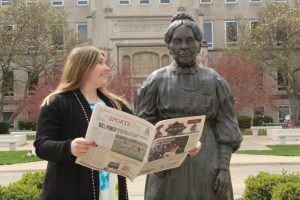Like any young female, I avoid walking alone late at night. But I never avoid walking alone during the day, and I don’t fear for my life on my way to class, unlike some students in Chicago.
Violence among young people, especially teens, is a glaring issue made even more evident by the recent brutal death of Chicago teen Derrion Albert, who was killed while walking home from school.
Albert, a sophomore and honor student at a Far South Side high school, was walking from school to a nearby bus stop last week when he got caught up in a brawl between two rival neighborhood groups. He was hit over the head with a splintered railroad tie more than once, punched repeatedly and stomped on before his attackers fled, according to a Times Wire Service story published Sept. 29 on the Chicago Tribune Web site. He died three hours later at a nearby hospital.
Police said the fight was the peak of a feud between a group of students from a public housing complex in the area and another group from a neighborhood close to the high school Albert attended, according the story.
Tensions had apparently been mounting for some time between the two groups, and students from both groups voiced concerns over being stalked and threatened by other students.
An amateur cell phone video of the attack on Albert made its rounds on news programs in an edited version and on the Internet in a non-edited version.
I haven’t had the stomach to watch either, but saw a few photo stills from the video. It was sickening.
Parents of students at the school are withdrawing their kids. Extra bus routes are quickly being added to avoid throngs of students waiting extra time for transportation. Chicago Public Schools are planning to roll out a $30 million safety plan this month.
And Derrion Albert is still dead.
The Chicago Public School system has seen its unfair share of student deaths. During the 2008-2009 school year, the district lost 34 students to fatal gunshot wounds, according to an NBC News story published Sept. 28.
And frighteningly, about 9 percent of murders in the U.S. were committed by teens under 18 in 2000, according to the National Youth Violence Prevention Resource Center.
Albert isn’t the first for Chicago, or the United States.
The city of Chicago is asking now: how could this happen?
The answer is that there is no answer. Parents are flinging the blame on school district officials and police, and the district is scrambling to inject money into a safety plan that will hopefully prevent something like this from occurring in the future.
Still, public schools shouldn’t breed fear. Like many parents at Albert’s school argued, school should be a safe haven. Throwing money at a problem and bussing in students who live farther away won’t solve an ingrained problem in the area.
Won’t these neighborhood feuds just erupt in the halls? On the buses? In the streets?
Steps should be taken to decrease tense behaviors within the students, rather than just further separating the feuding groups.
Understanding fosters peace. A walk home from school shouldn’t turn into a bloody mob.
Annette Holt, mother of a Chicago Public Schools student who was shot on a city bus in 2007, said Albert’s death was yet another premature ending to a promising future.
“Someone said he [Albert] was in the wrong place at the wrong time,” she said in the Times Wire Service article. “No, he wasn’t. He was in the right place. He was coming from school.”
Lauren Rees is a senior journalism major from Schaumburg. She is a Scout staff reporter.
Direct comments, questions and other responses to lrees@mail.bradley.edu.



